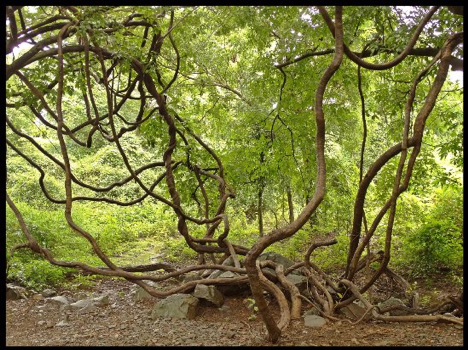Module 4: Tropical Forest Plant Growth Forms as Related to Natural Forest Management
Topic 4.3: Vines and Lianas, Or Climbers
Vines, including woody vines or “lianas,” are abundant in most tropical forests, often reaching alarming densities after severe disturbances. Because they allocate little tissue for mechanical self-support, vine stems are capable of phenomenal rates of extension growth (5-10 m per year is not unusual). The same patterns and rates of growth observed above-ground apparently also occur below-ground; vine roots tend to be thin, fast-growing, and extensive, both horizontally and vertically. Because vine stems typically have large diameter and long xylem vessels with a tremendous capacity for conduction, even vines with small diameter stems can support extremely large numbers of leaves. Their deep roots may also allow vines to retain more leaves for longer into the dry season than trees growing in the same forest.

Figure 4.3.1. Lianas, but note that the trellises they originally ascended are long gone.
Vines are very effective competitors with the trees upon which they depend for mechanical support. They compete for water and nutrients below-ground, and for light above-ground. The twining stems and tendrils of vines also can girdle tree trunks and branches. Furthermore where woody vines are abundant and tie tree crows together, felling vine-laden trees can exacerbate damage to the residual forest. Finally, because vine stems are generally thin and flexible and contain abundant living cells in the xylem that aid in recovery from damage (e.g., successive cambia and intruded phloem), the vines on felled trees often survive, produce adventitious roots along the fallen stem, and proliferate in the newly created canopy gap, often to the exclusion of tree seedlings.
Vines have many beneficial ecosystem functions and may themselves be commercially valuable. The intercrown connections provided by vines, for example, provide arboreal pathways for many canopy animals. And vine fruits, seeds, and leaves provide food for large but as yet unknown numbers of forest vertebrates and invertebrates. People use vines for building materials and basketry (e.g., rattans and other climbing palms), medicines and poisons (e.g., strychnine), and food (e.g., grapes and cucurbits).
Reducing the density of vines is often necessary to promote tree growth but silviculturalists must balance this benefit against the cost to biodiversity and ecosystem function. Mitigating the deleterious impacts of vine-cutting as a silvicultural treatment seems feasible; not cutting fleshy-fruit producing species and leaving large areas untreated seem like reasonable approaches to mitigation.
